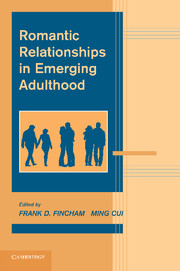Book contents
- Frontmatter
- Contents
- List of Contributors
- Foreword
- PART I INTRODUCTION
- PART II CONCEPTUAL AND METHODOLOGICAL FOUNDATIONS
- 2 Romantic Relationships in Emerging Adulthood: Conceptual Foundations
- 3 Relationship Sequences and Trajectories: Women's Family Formation Pathways in Emerging Adulthood
- 4 Models of Change and Continuity in Romantic Experiences
- 5 Working With Dyadic Data in Studies of Emerging Adulthood: Specific Recommendations, General Advice, and Practical Tips
- PART III THE DEVELOPMENTAL CONTEXT OF ROMANTIC RELATIONSHIPS IN EMERGING ADULTHOOD
- PART IV RELATIONSHIP PROCESSES IN EMERGING ADULTHOOD
- PART V PRACTICAL IMPLICATIONS
- Index
- References
4 - Models of Change and Continuity in Romantic Experiences
Published online by Cambridge University Press: 06 December 2010
- Frontmatter
- Contents
- List of Contributors
- Foreword
- PART I INTRODUCTION
- PART II CONCEPTUAL AND METHODOLOGICAL FOUNDATIONS
- 2 Romantic Relationships in Emerging Adulthood: Conceptual Foundations
- 3 Relationship Sequences and Trajectories: Women's Family Formation Pathways in Emerging Adulthood
- 4 Models of Change and Continuity in Romantic Experiences
- 5 Working With Dyadic Data in Studies of Emerging Adulthood: Specific Recommendations, General Advice, and Practical Tips
- PART III THE DEVELOPMENTAL CONTEXT OF ROMANTIC RELATIONSHIPS IN EMERGING ADULTHOOD
- PART IV RELATIONSHIP PROCESSES IN EMERGING ADULTHOOD
- PART V PRACTICAL IMPLICATIONS
- Index
- References
Summary
The development of romantic relationships commonly begins in adolescence and continues to unfold over the life course. Over the course of time, a romantic relationship may take on new characteristics, acquire new meaning, and serve new functions (Furman & Collins, 2009). For example, the attachment and caregiving behavioral systems typically become more salient as the relationship develops (Furman & Wehner, 1994).
Of particular importance are the formative experiences and developmental processes that occur during emerging adulthood. The salience of romantic relationships increases across these years, rivaling and sometimes surpassing those with parents and eclipsing those with friends (Laursen & Williams, 1997). Many emerging adults face decisions about long-term commitment, including cohabitation and marriage.
Not only do particular romantic relationships change and develop but also changes can occur across relationships. Emerging adulthood is often a time of exploration, and many persons during this period have a series of different romantic relationships. As relationship experiences accumulate, patterned styles of interacting with romantic partners may emerge or change (Laursen & Jensen-Campbell, 1999). These developmental processes are complicated and multiple in nature. One of the key questions social scientists face is how best to capture the changes and development that occur in romantic relationships and experiences in emerging adulthood.
Over the last two decades, statisticians have developed a range of different statistical procedures to analyze change and development. Traditionally, autoregressive models were the method of choice with longitudinal data.
- Type
- Chapter
- Information
- Romantic Relationships in Emerging Adulthood , pp. 44 - 66Publisher: Cambridge University PressPrint publication year: 2010
References
- 3
- Cited by



